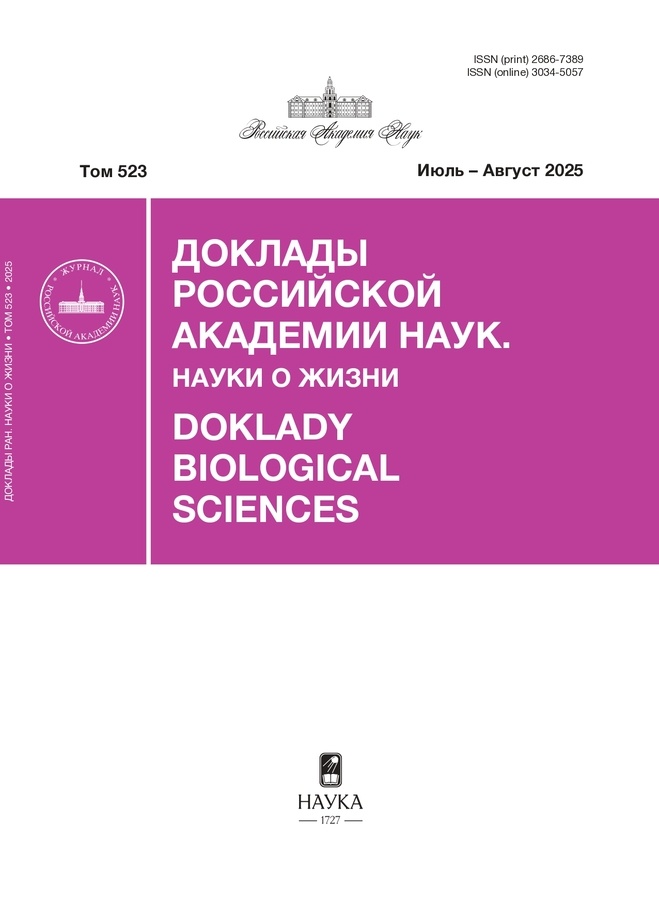Новые N6-замещенные производные аденина с высокой противовирусной активностью в отношении РНК-содержащих вирусов
- Авторы: Зенченко А.А.1, Семенова Ю.Д.1, Набережная Е.Р.1, Гуменная Я.Д.1, Липатова А.В.1, Ословский В.Е.1
-
Учреждения:
- Институт молекулярной биологии им. В.А. Энгельгардта Российской академии наук
- Выпуск: Том 520, № 1 (2025)
- Страницы: 104-108
- Раздел: Статьи
- URL: https://gynecology.orscience.ru/2686-7389/article/view/682052
- DOI: https://doi.org/10.31857/S2686738925010178
- EDN: https://elibrary.ru/tcbjwc
- ID: 682052
Цитировать
Полный текст
Аннотация
В настоящей работе было выявлено два новых соединения, N6-(4,5-диметоксифенил)аденин и N6-(3,5-ди-трифторметилфенил)аденин, обладающие широким спектром противовирусного действия в отношении РНК-содержащих вирусов. Мы показали, что данные соединения проявляют выраженную противовирусную активность в отношении полиовируса человека 1, 2 и 3 типов, принадлежащих к энтеровирусам группы С. Оба соединения также демонстрировали выраженную противовирусную активность в отношении Коксаки вирусов B3, B5 и B6, принадлежащих к энтеровирусам группы B. Кроме того, соединения демонстрировали противовирусную активность в отношении вируса болезни Ньюкастла, принадлежащего к роду парамиксовирусов. Описанные в данной работе соединения в дальнейшем могут служить в качестве прототипов для создания новых противовирусных лекарственных препаратов, в отношении эпидемиологически значимых РНК-вирусов человека.
Полный текст
Об авторах
А. А. Зенченко
Институт молекулярной биологии им. В.А. Энгельгардта Российской академии наук
Email: vladimiroslovsky@gmail.com
Россия, Москва
Ю. Д. Семенова
Институт молекулярной биологии им. В.А. Энгельгардта Российской академии наук
Email: vladimiroslovsky@gmail.com
Россия, Москва
Е. Р. Набережная
Институт молекулярной биологии им. В.А. Энгельгардта Российской академии наук
Email: vladimiroslovsky@gmail.com
Россия, Москва
Я. Д. Гуменная
Институт молекулярной биологии им. В.А. Энгельгардта Российской академии наук
Email: vladimiroslovsky@gmail.com
Россия, Москва
А. В. Липатова
Институт молекулярной биологии им. В.А. Энгельгардта Российской академии наук
Email: vladimiroslovsky@gmail.com
Россия, Москва
В. Е. Ословский
Институт молекулярной биологии им. В.А. Энгельгардта Российской академии наук
Автор, ответственный за переписку.
Email: vladimiroslovsky@gmail.com
Россия, Москва
Список литературы
- Romanov, G.A., How do cytokinins affect the cell? Rus. J. Plant Physiol., 2009, Vol. 56, P. 268–290.
- Fathy, M., Saad Eldin, S.M., Naseem, M., et al., Cytokinins: Wide-Spread Signaling Hormones from Plants to Humans with High Medical Potential, Nutrients. 2022, Vol. 14, P. 1495.
- Drenichev, M.S., Oslovsky, V.E., Mikhailov, S.N., Cytokinin Nucleosides – Natural Compounds with a Unique Spectrum of Biological Activities, Curr. Top. Med. Chem. 2016, Vol. 16, P. 2562–2576.
- Oshchepkov, M.S., Kalistratova, A.V., Savelieva, E.M., et al., Natural and synthetic cytokinins and their applications in biotechnology, agrochemistry and medicine, Russ. Chem. Rev. 2020, Vol. 89, P. 787.
- Salerno, M., Varricchio, C., Bevilacqua, F., et al., Rational design of novel nucleoside analogues reveals potent antiviral agents for EV71. Eur. J. Med. Chem. 2023, Vol. 246, P. 114942.
- Drenichev, M.S., Oslovsky, V.E., Sun, L., et al., Modification of the length and structure of the linker of N6-benzyladenosine modulates its selective antiviral activity against enterovirus 71. Eur. J. Med. Chem. 2016, Vol. 111, P. 84–94.
- Graci, J.D., Too, K., Smidansky, E.D., et al., Lethal mutagenesis of picornaviruses with N-6-modified purine nucleoside analogues. Antimicrob. Agents Chemother. 2008, Vol. 52, P. 971–979.
- Drake, J.W., Holland, J.J., Mutation rates among RNA viruses, Proc. Nat. Acad. Sci. 1999, Vol. 96, P. 13910–13913.
- Sanjuán, R., Nebot, M.R., Chirico, N., et al., Viral mutation rates, J. Virol. 2010, vol. 84, pp. 9733–9748.
- Zenchenko, A.A., Drenichev, M.S., Mikhailov, S.N., Nucleoside Inhibitors of Coronaviruses, Curr. Med. Chem. 2021, Vol. 28, P 5284–5310.
- De Clercq, E., Li, G., Approved antiviral drugs over the past 50 years, Clin. Microbiol. Rev. 2016, Vol. 29, P. 695–747.
- Ertl, P., Jelfs, S., Muhlbacher, J., et al. Quest for the Rings. In Silico Exploration of Ring Universe to Identify Novel Bioactive Heteroaromatic Scaffolds, J. Med. Chem. 2006, Vol. 49, P. 4568–4573.
- Sakakibara, H., Cytokinins: activity, biosynthesis, and translocation, Ann. Rev. Plant Biol. 2006, Vol. 57, P. 431–449.
- Doležal, K., Popa, I., Krystof, V., et al. Preparation and biological activity of 6-benzylaminopurine derivatives in plants and human cancer cells, Bioorg. Med. Chem. 2006, Vol. 14, P. 875–884.
- Plihalova, L., Vylíčilová, H., Doležal, K., et al., Synthesis of aromatic cytokinins for plant biotechnology. New biotechnology. 2016, Vol. 33, P. 614–624.
- Reed, L.J., Muench, H., A simple method of estimating fifty per cent endpoints, Am. J. Epidemiol. 1938, Vol. 27, P. 493–497.
- Qiu, L., Patterson, S.E., Bonnac, et al., Nucleobases and corresponding nucleosides display potent antiviral activities against dengue virus possibly through viral lethal mutagenesis. PLoS Negl. Trop. Dis., 2018, Vol. 12, P. e0006421.
- Zenchenko, A.A., Drenichev, M.S., Il’Icheva, I.A., Mikhailov, S.N., Antiviral and antimicrobial nucleoside derivatives: structural features and mechanisms of action. Mol. Biol., 2021, Vol. 55, P. 786–812.
- Ramaswamy, K., Rashid, M., Ramasamy, S., et al., Revisiting viral RNA-dependent RNA polymerases: insights from recent structural studies. Viruses, 2022, Vol. 14, P. 2200. DOI:
- Venkataraman, S., Prasad, B. V., Selvarajan, R., RNA dependent RNA polymerases: insights from structure, function and evolution. Viruses, 2018, Vol. 10(2), P. 76.
Дополнительные файлы










